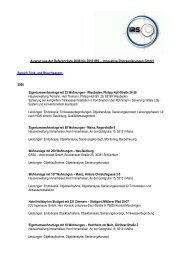Rechtliche Würdigung der Empfehlungen und Leitlinien des ...
Rechtliche Würdigung der Empfehlungen und Leitlinien des ...
Rechtliche Würdigung der Empfehlungen und Leitlinien des ...
Sie wollen auch ein ePaper? Erhöhen Sie die Reichweite Ihrer Titel.
YUMPU macht aus Druck-PDFs automatisch weboptimierte ePaper, die Google liebt.
– They can positively list those technical standards, whose fulfilment implies the<br />
fulfilment of the legal binding standard.<br />
5. Because the state relinquishes some of its legislative power to private bodies and because<br />
of the great factual impact of technical standards on the market position of enterprises as<br />
well as on the protection of workers, consumers and the environment the following<br />
minimal procedural requirements must be met:<br />
– The relevant expertise must be comprehensively represented within the norm finding<br />
committees.<br />
– All affected interest groups must be represented in a balanced manner.<br />
– The public must have the opportunity to influence the contents of the evolving<br />
technical standards.<br />
– Technical standards must be revised in regular intervals.<br />
– Binding procedural rules must be defined.<br />
Generally Acknowledged Technical Standards, Standard of Technology, Standard of<br />
Science and Technology<br />
6. The choice between the three prevailing general clauses (generally acknowledged<br />
technical standards, standard of technology and standard of science and technology)<br />
influences the delay between technical or scientific development and its legal reception.<br />
7. Generally acknowledged technical standards and acknowledged technical standards<br />
(these terms are synonymous) are technical requirements for procedures, installations and<br />
operating conditions that<br />
– [according to the prevailing opinion of the participating parts of society (experts,<br />
users, consumers and public authorities)] are appropriate to reach the legal aim,<br />
– consi<strong>der</strong> economic aspects among broa<strong>der</strong> consi<strong>der</strong>ations on proportionality,<br />
– have proven themselves in practice, or that, according to the predominant view, will<br />
prove themselves in near future.<br />
8. The general clause ‘generally acknowledged technical standards’ (GATS) forms the traditional<br />
set of requirements and is used in cases of relatively small potentials of danger.<br />
Usually one can have recourse to an existing standard. The reference point of GATS is<br />
not the innovative behaviour of few actors but that of a broad range of ‘normal users’.<br />
Technical norms define minimal standards that can be broadly and comprehensively put<br />
into practice. Therefore, they consi<strong>der</strong> economic interests, practical conditions and the<br />
addressees’ qualification.<br />
9. GATS can develop further independently and leave formalized, written standards behind.<br />
Written standards do not necessarily correspond to the current technological knowledge,<br />
and sometimes they contain rules that will or have not proven themselves. Codified<br />
technical standards that are not revised regularly can become obsolete and thus cannot be<br />
regarded as GATS any more.<br />
10. In cases where plants, devices or substances show a complex potential for risks and<br />
where the knowledge and procedures to estimate and handle the risk are subject to a<br />
continuous revision process, legislators refer to the more demanding standard of<br />
technology. The procedures, installations and operatinmg conditions need not have<br />
proven themselves. Yet, recourse to comparable techniques that have already been tested<br />
shall be taken to determine this standard. Therefore this standard is moved from the<br />
XVIII



